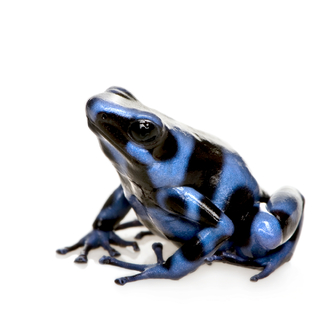Located at the lower level entry to the Boettcher Memorial Tropical Conservatory is one of two poison dart frog terraria. These blue frogs are the newest addition to our small collection of poison dart frogs. The species,
Dendrobates auratus, has a natural range from southeastern Nicaragua to northwestern Colombia. Most members of this species are green and black, but the blue form you see here is found only in Panama. The whole family of frogs is diurnal, making them ideal for public display: they are awake and active while our visitors are here.
D. auratus was introduced into Hawaii in 1932 as a control for non-native insects. They survive there today, but unlike some species introduced on the island, have not significantly altered the ecosystem by competing with native species.
Poison Frogs: Where does the poison come from?
Frogs in the family Dendrobatidae secrete poisons from their skin. Unable to manufacture these toxins themselves, they rely on their diet for the source of their poisons. Some plants in the rainforest produce alkaloids, toxins that discourage herbivores. Despite these protections, some insects such as ants and mites, adapted to have immunity to the toxins, eat the plants and store the alkaloids. Dendrobatid frogs, also immune to the toxins, eat these toxic insects and use the poison as protection!
A healthy forest makes a healthy frog
Frogs are commonly considered bioindicators, species that measure the health of the ecosystem in which they live. Poison frogs are some of the first organisms to show the consequences of pollution. They have thin permeable skin, the ability to absorb and concentrate toxins, and they have everyday contact with water. This makes them especially prone to population declines or genetic malformations caused by pollution. In addition, rainforest loss depletes food sources for the poison frogs; many poison frog species have now been placed on the endangered species list.
Terrarium- A rainforest in miniature
Not only is this terrarium an attractive home for our amphibian friends, it is also a good tool for growing some small and delicate tropical plants. The glass enclosure helps maintain high levels of humidity and moderates temperature for sensitive plants. A light hood enables hobbyists to grow plants in low light areas of the house. Among the many plants suitable for a tropical terrarium are African violets, small ferns, and some orchids and bromeliads.











 E-mail
E-mail










_MINI2.jpg)

_MINI2.jpg)














































































_MINI2.jpg)







